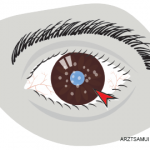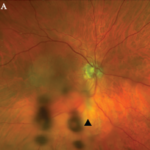Our personal experience in a prospective study of infliximab for various types of refractory uveitis demonstrated marked efficacy as well as unexpected toxicity. Among 31 studied patients, side effects included three cases of drug-induced lupus and three thromboses (two with pulmonary emboli and one with myocardial infarction). While this study is too small to conclude that patients with uveitis are especially susceptible to toxic effects from infliximab, we speculate that patients who have localized inflammation may be more prone to adverse events from systemic inhibition of a cytokine.25
TNF inhibitors reduce the frequency of uveitis in patients with AS who are prone to recurrent bouts of eye inflammation.
To date only one report has addressed the efficacy of adalimumab for uveitis. Although this report is favorable, greater study is needed before this approach is adopted widely.
Our approach is to recommend a TNF-inhibitor in the form of a monoclonal antibody for patients with uveitis who have failed other immunosuppressives and who have a systemic disease such as a spondylarthropathy that should respond to this approach. Ironically, although infliximab is not FDA-approved for JIA, high doses of infliximab are reportedly effective for the uveitis associated with JIA.
Experience using rituximab for uveitis is limited and many other biologics, such as abatacept and alefacept, are essentially unstudied. An open-label study using rituximab for scleral and orbital disease is currently underway at our institution.
Conclusion
While rheumatologists and ophthalmologist often speak a different language, they share a mutual responsibility for patients with systemic illness whose vision requires their combined efforts. An understanding of the ocular manifestations of rheumatic disease enables a rheumatologist to have the gratifying opportunity to protect or restore vision in a subset of patients with sight-threatening inflammation.
Dr. Pasadhika is a fellow in the ophthalmology department at Casey Eye Institute and an instructor in the ophthalmology department at Chulalongkorn University Hospital in Bangkok, Thailand. Dr. Rosenbaum is professor of medicine, ophthalmology, and cell biology and director of inflammation research at OHSU and director of the Uveitis Clinic at Casey Eye Institute.
References
- Hamideh F, Prete PE. Ophthalmologic manifestations of rheumatic diseases. Semin Arthritis Rheum. 2001;30:217-241.
- Jabs DA, Nussenblatt RB, Rosenbaum JT; Standardization of Uveitis Nomenclature (SUN) Working Group. Standardization of uveitis nomenclature for reporting clinical data. Results of the First International Workshop. Am J Ophthalmol. 2005;140:509-516.
- Martin TM, Smith JR, Rosenbaum JT. Anterior uveitis: current concepts of pathogenesis and interactions with the spondyloarthropathies. Curr Opin Rheumatol. 2002;14:337-341.
- Power WJ, Rodriguez A, Pedroza-Seres M, et al. Outcomes in anterior uveitis associated with the HLA-B27 haplotype. Ophthalmology. 1998;105:1646-1651.
- Tay-Kearney ML, Schwam BL, Lowder C, et al. Clinical features and associated systemic diseases of HLA-B27 uveitis. Am J Ophthalmol. 1996;121:47-56.
- Kiss S, Letko E, Oamruddin S, et al. Long-term progression, prognosis, and treatment of patients with recurrent ocular manifestations of Reiter’s syndrome. Ophthalmology. 2003;110:1764-1769.
- Ghanchi FD, Rembacken BJ. Inflammatory bowel disease and the eye. Surv Ophthalmol. 2003;46:663-676.
- Salmon JF, Wright JP, Murray AD. Ocular inflammation in Crohn’s disease. Ophthalmology. 1991;98:480-484.
- Paiva ES, Macaluso DC, Edwards A, et al. Characterisation of uveitis in patients with psoriatic arthritis. Ann Rheum Dis. 2000;59:67-70.
- Mackensen F, Smith JR, Rosenbaum JT. Enhanced recognition, treatment, and prognosis of tubulointerstitial nephritis and uveitis syndrome. Ophthalmology. 2007;114:995-999.
- Cunningham ET. Uveitis in children. Ocul Immunol Inflamm. 2000;8:251-261.
- American Academy of Pediatrics Section on Rheumatology and Section on Ophthalmology. Guidelines for ophthalmologic examinations in children with juvenile rheumatoid arthritis. Pediatrics. 1993;92:295-296.
- Evereklioglu C. Current concepts in the etiology and treatment of Behçet disease. Surv Ophthalmol. 2005;50:297-350.
- Zaidman GW. The ocular manifestations of Lyme disease. Int Ophthalmol Clin. 1997;37:13-28.
- Jones NP. Sarcoidosis. Curr Opin Ophthalmol. 2002;13:393-396.
- Rose CD, Wouters CH, Meiorin S, et al. Pediatric granulomatous arthritis: an international registry. Arthritis Rheum. 2006;54:3337-3344.
- Grasland A, Pouchot J, Hachulla E, et al. Typical and atypical Cogan’s syndrome: 32 cases and review of literature. Rheumatology. 2004;43:1007-1015.
- Arevalo JF, Lowder CY, Muci-Mendoza R. Ocular manifestations of systemic lupus erythematosus. Curr Opin Ophthalmol. 2002;13:404-410.
- Akova YA, Jabbur NS, Foster CS. Ocular presentation of polyarteritis nodosa. Clinical course and management with steroid and cytotoxic therapy. Ophthalmology. 1993;100:1775-1781.
- Pakrou N, Selva D, Leibovitch I. Wegener’s granulomatosis: ophthalmic manifestations and management. Semin Arthritis Rheum. 2006;35:284-292.
- Hoffman GS, Kerr GS, Leavitt RY, et al. Wegener granulomatosis: an analysis of 158 patients. Ann Intern Med. 1992;116:488-498.
- Jabs DA, Rosenbaum JT, Foster CS, et al. Guidelines for the use of immunosuppressive drugs in patients with ocular inflammatory disorders: recommendations of an expert panel. Am J Ophthalmol. 2000;130:492-513.
- Lim L, Suhler EB, Smith JR. Biologic therapies for inflammatory eye disease. Clin Experiment Ophthalmol. 2006;34:365-374.
- Theodossiadis PG, Markomichelakis NN, Sfikakis PP. Tumor necrosis factor antagonists: preliminary evidence for an emerging approach in the treatment of ocular inflammation. Retina. 2007;27:399-413.
- Suhler EB, Smith JR, Wertheim MS, et al. A prospective trial of infliximab therapy for refractory uveitis: preliminary safety and efficacy outcomes. Arch Ophthalmol. 2005;123:903-912.



